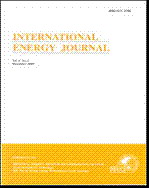ThaiScience
ThaiScience
INTERNATIONAL ENERGY JOURNAL
Volume 21, No. 03, Month SEPTEMBER, Year 2021, Pages 385 - 400
Computational fluid dynamic (cfd) analysis of propeller turbine runner blades using various blade angles
Pribadyo Pribadyo, Hadiyanto Hadiyanto, Jamari Jamari
Abstract Download PDF
In this study, computational fluid dynamics (CFD) methods were adopted to predict the runner blade performance of the propeller turbine. The geometrical parameters and internal performance parameters, such as flowrate (0.08 – 0.2 m3 /s), and the turbine runner model based on the three different blade angles (i.e., 25 degrees, 30 degrees, and 35 degrees), were analyzed, using Fluent ver.18.2. CFD commercial code. The Reynolds Averaged Navier Stokes equation with the shear stress transport k-ω turbulence models used to simulate the unsteady model, to predict the turbine performances by investigating dimensionless parameters such as tip speed ratio (λ), power coefficient (Cp), torque (T), etc. The performance characteristics of the runner blade on CFD data were compared with the reference case to analyze the suitability of the blade angle in potential energy extraction. The analysis found that the interaction between the flowrate and blade angle affects the performance of the turbine. The performance efficiency of the runner blade had also consistently shown the characteristic trend of nonlinear increases to peak to an optimum value, before decreasing with increased blade angle. Results found that both the power coefficient and the efficiency were higher for the blade angle of 25 degrees than for the blade angles of 30 degrees and 35 degrees.
Keywords
Blade angle, Hydropower energy, Propeller turbine, Runner blade, Simulation CFDINTERNATIONAL ENERGY JOURNAL
Published by : Asian Institute of Technology
Contributions welcome at : http://www.rericjournal.ait.ac.th
